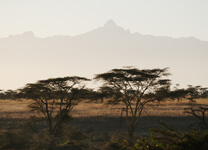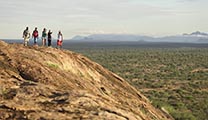
Angama Mara
- Maasai Mara National Reserve, KenyaConsidered by safari lovers as one of the lovliest positions in the Mara, if not all of Kenya, Angama Mara is suspended 300m above the Mara Triangle.

Kenya has endless savannah plains and scorched deserts interrupted by snow-capped mountains, cool highlands and equatorial forests. The scenic coastline possesses the atmosphere of a paradise island and is sprinkled with colourful coral reefs.
The highland areas of Central Kenya – including the Laikipia Plateau – provide rich soil for farming, making Kenya one of the most agriculturally productive countries in Africa; this area is considered the fertile breadbasket of the Kenyan people. Four rivers, of which one is perennial, flow through the area making for an even more compelling locale for animals and people alike.
Things to look forward to in Kenya:Considered the gateway to Kenya’s northern frontier country, the cool and temperate Laikipia Plateau, on the Central Highlands, is wild and scarcely populated.

The Maasai Mara (or Spotted Plains) is a national reserver on the southwestern side of Kenya. It is on the border of Tanzania. Some of the animals in the region include lions, cheetahs, elephants, zebras, hippos, and rhinos. It's abundant wildlife, endless plains, and breathtaking vistas make it a popular destination. There is excellent game viewing all year, but the Great Migration brings millions of animals to the area.

It's a place of rich diversity and home to the Samburu people. There are several national reserves in the area that have abundant wild life. Samburu is also home to all of the big cats. You may get to see Grevy's zebra, besia oryx, and the 'Samburu Big 5'. It is generally hot during the day and cool at night. The dry seasons are the best times to visit (December - March and June - October).

Kenya plays host to an almost unrivalled array of birds, mammals, reptiles and amphibians. The famous wildebeest herds of the Mara are a small part of the fauna of a country that is associated with Africa's wild savannah.
The Laikipia Plateau is a conservancy area of 9 500 sq. km, and a major component of the Ewaso Ecosystem, which supports the second highest density of wildlife in Kenya. Ewaso is home to 7 000 elephant, Kenya's second largest herd, as well as lion, leopard and buffalo. It also supports important populations of black rhino, some 2 000 Grevy's zebra (70% of the world's population), 2 000 of the global population of reticulated giraffe, Kenya's only viable populations of the endangered patas monkey, and Lelwel hartebeest, as well as one of the few expanding populations of African wild dog.
April and May see the end of the ‘long rains’ in Kenya, with November seeing the ‘short rains’. July and August are usually overcast and cool, and continental rains anywhere between June and October. These rains bring a clear air, lush surrounds and thus wonderful photographic opportunities. Streams here only flow after a good downpour. With less haze, views of the iconic Mount Kenya are good and make for outstanding backdrops to those photos.
When the rains begin, many small plant species burst into flower, covering the area in a multihued carpet, from white ‘tissue paper’ flowers to yellow daisy species, all followed by butterflies. During this time, herds of grazers like plains zebra, gazelles and their predators move onto Segera's lush plains.
January and February are the hottest and driest times of the year; during this period therefore, wildlife tends to concentrate around the remaining water sources including the Ewaso Nyiro River and Segera's various waterholes. Good sightings of predators and other wildlife of the Ewaso ecosystem (of which Segera is part) include its stable populations of elephant, iconic Grevy’s zebra, reticulated giraffe, and the Endangered patas monkey, all common sights year round.
The haze over the land means that long-range views of Mount Kenya are not as good as in the green season. However, September and October being warm and dry, means it is most comfortable for wildlife viewing.